Yellow Crane Tower
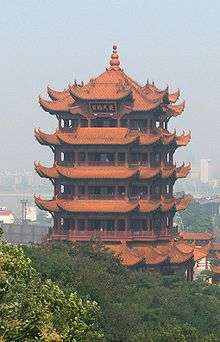
| Yellow Crane Tower | |||||||||||||||||||
.svg.png) "Yellow Crane Tower" in Simplified (top) and Traditional (bottom) Chinese characters | |||||||||||||||||||
| Simplified Chinese | 黄鹤楼 | ||||||||||||||||||
|---|---|---|---|---|---|---|---|---|---|---|---|---|---|---|---|---|---|---|---|
| Traditional Chinese | 黃鶴樓 | ||||||||||||||||||
| |||||||||||||||||||
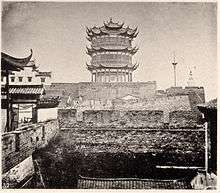
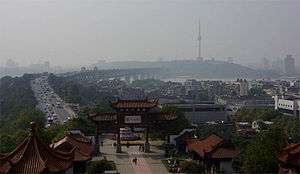
Yellow Crane Tower (traditional Chinese: 黃鶴樓; simplified Chinese: 黄鹤楼; pinyin: Huánghè Lóu) is a traditional Chinese tower located in Yellow Crane Tower Subdistrict, Wuchang District, Wuhan, in central China. The current structure was built in 1981, but the tower has existed in various forms since not later than AD 223. The current Yellow Crane Tower is 51.4 m (169 ft) high and covers an area of 3,219 m2 (34,650 sq ft). It situated on Snake Hill (蛇山), one kilometer away from the original site, on the banks of the Yangtze River in Wuchang District.
History
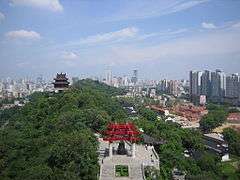
The Yuanhe Maps and Records of Prefectures and Counties, written almost 600 years after the construction of the tower, notes that after Sun Quan, founder of the kingdom of Eastern Wu, built the fort of Xiakou in 223, a tower was constructed at/on the Yellow Crane Jetty, west of Xiakou, and hence its name.[1][2]
The tower has been destroyed twelve times, both by warfare and by fire, in the Ming and Qing dynasties and was repaired on ten separate occasions. The last tower at the original site was built in 1868 and destroyed in 1884. In 1957, the Wuhan Yangtze River Bridge was built with one trestle of the bridge on the Yellow Crane Tower's site. In 1981, the Wuhan City Government commenced reconstruction of the tower at a new location, about 1 km (0.62 mi) from the original site, and it was completed in 1985.[3]
On January 31, 2018, Theresa May, Prime Minister of the United Kingdom, visited Wuhan and took pictures at the Yellow Crane Tower.[4]
Legends
Notwithstanding the tower's current location on Snake Hill being unrelated to its original location one kilometre away, the two popular legends related to it invoke the hill. In the first, an Immortal (仙人) named Wang Zi'an (王子安) rode away from Snake Mountain on a yellow crane and a tower was later built in commemoration of this story. In the second legend, Fei Wenyi (费文祎) becomes immortal and rides a yellow crane, often stopping on Snake Hill to take a rest.[5]
The tower is also a sacred site of Daoism. Lü Dongbin is said to ascend to heaven from here.[6] There is a small cave in the hill beneath the tower with Lü Dongbin stature. The cave is been called Lü Zu Dong, literately means cave of Lü Dongbin.
Literature
Poem by Cui Hao
Yellow Crane Tower was made famous by an 8th-century poem written by Cui Hao, titled "Yellow Crane Tower" (黄鹤楼).[7] The original text of the poem is shown below (in Simplified Chinese):
昔人已乘黄鹤去,此地空余黄鹤楼。
黄鹤一去不复返,白云千载空悠悠。
晴川历历汉阳树,芳草萋萋鹦鹉洲。
日暮乡关何处是?烟波江上使人愁。
A modern English translation is:
Long ago one's gone riding the yellow crane,[8] all that remained is the Yellow Crane Tower.
Once the yellow crane left it will never return, for one thousand years the clouds wandered carelessly.
The clear river reflects each Hanyang tree, fragrant grasses lushly grow on Parrot Island.[9]
At sunset, which direction leads to my hometown? One could not help feeling melancholy along the misty river.
Poem by Li Bai
There are other famous poems about the Yellow Crane Tower by Li Bai. One was written on the occasion of Bai parting with his friend and poetic colleague, Meng Haoran. The poem is titled "Seeing off Meng Haoran for Guangling at Yellow Crane Tower" (黄鹤楼送孟浩然之广陵), and is shown in its original form below:
故人西辞黄鹤楼,
烟花三月下扬州。
孤帆远影碧空尽,
唯见长江天际流。
A modern English translation is:
My old friends said goodbye to the west, here at Yellow Crane Tower,
In the third month's cloud of willow blossoms, he's going down to Yangzhou.
The lonely sail is a distant shadow, on the edge of a blue emptiness,
All I see is the Yangtze River flow to the far horizon.
Modern Association With Poetry
As of 1988, one of the top floors in the Yellow Crane Tower is reserved for visiting poets of note, and the general public is only allowed to view it from the outside. This floor is fully equipped with desks, chairs, papers, brushes and inks.
Tourism
The tower and its surroundings have been marked as Yellow Crane Tower park. There is tour services can be added with fee at entrance. The top of the tower has a broad view of its surroundings and the Yangtze River. Yellow Crane Tower is considered one of the Four Great Towers of China. In its modern version, it has the appearance of an ancient tower but is built of modern materials, including an elevator.[10] Each level has its own display. To the east on the hill, a large temple bell may be rung by tourists for a small fee. There are court dances in the western yard during the week-long celebration of China's National Day (October 1). The tower is classified as an AAAAA scenic area by the China National Tourism Administration.[11] At south side of the tower, there is a stature of Yuefei because he was garrison around this area in Song Dynasty.
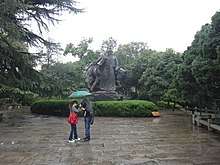
See also
References
- ↑ "元和郡縣圖志 卷第二十七 (Yuanhe Maps and Records of Prefectures and Counties, Chapter 27)" (in Traditional Chinese). Chinese Text Project. Retrieved 30 December 2017.
州城本夏口城,吳黃武二年[223],城江夏以安屯戍地也。城西臨大口,西南角因磯為樓,名黃鶴樓。
- ↑ Yuanhe Maps and Records of Prefectures and Counties (元和郡縣圖志), Li, Jifu, and He, Cijun (李吉甫 賀次君). 1983. Zhongguo gu dai di li zong zhi cong kan (中國古代地理總志叢刊). Beijing: Zhong hua shu ju (中華書局 : 新華書店北京發行所發行).
- ↑ Fang Wang (14 April 2016). Geo-Architecture and Landscape in China’s Geographic and Historic Context: Volume 1 Geo-Architecture Wandering in the Landscape. Springer. pp. 43–. ISBN 978-981-10-0483-4.
- ↑ http://www.dzwww.com/xinwen/guoneixinwen/201802/t20180201_16992854.htm
- ↑ Wan: The source of the Wang Zi'an legend is 《南齐书·州郡志》. The Fei Wenyi legend is from 《太平寰宇记》. Pages 43.
- ↑ Images of the Immortal: The Cult of Lü Dongbin at the Palace of Eternal Joy by Paul R. Katz, University of Hawaii Press, 1999, page 80
- ↑ Wan: Page 42.
- ↑ Wan: Several Tang sources use "cloud" (白云) rather than "yellow crane" here. The use of "yellow crane" is a later change. Page 43.
- ↑ Wan: Parrot Island was a sandbar in the middle of the river that has since disappeared. Page 43.
- ↑ Li Shiqiao (29 April 2014). Understanding the Chinese City. SAGE Publications. pp. 177–. ISBN 978-1-4739-0539-9.
- ↑ "AAAAA Scenic Areas". China National Tourism Administration. 16 November 2008. Retrieved 9 April 2011.
- Wan, Jingjun (Chinese: 万竞君; pinyin: Wàn Jìngjūn) 1982. Cui Hao Poem Annotations (simplified Chinese: 崔颢诗注; traditional Chinese: 崔顥詩注; pinyin: Cuī Hào Shī Zhù). Shanghai Ancient Books Press (Chinese: 上海古籍出版社; pinyin: Shànghǎi Gǔjí Chūbǎnshè). 54 pages.
External links
| Wikimedia Commons has media related to Yellow Crane Tower. |
Coordinates: 30°32′49″N 114°17′49″E / 30.54694°N 114.29694°E